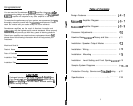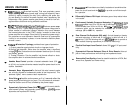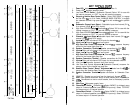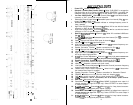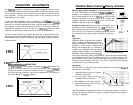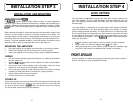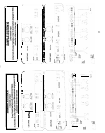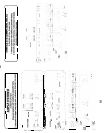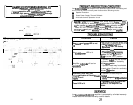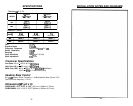
CROSSOVER ADJUSTMENTS
Hawkins Bass Control
-
Theory and Use
The
RUBICON
amplifiers incorporate an on-board staggered electronic cross-
over, with RCA outputs to drive an external amplifier. No external electronic cross-
over is necessary. However, if you do desire to use an external crossover you still
have the option.
The high and low pass portions of the crossover can be set
independently of one another.
In many car audio installations, there is a tendency for a “midbass boom.” Be-
cause of their interior dimensions, most cars will resonate or ring at these midbass
frequencies. If we design the system so there is reduced output in this region, the
final response is very smooth and natural sounding. The high pass crossover is
independently variable from 65 to 220 Hz at 12 dB/Octave, and the low pass
crossover is independently variable from 30 to 120 Hz at 24 dB/Octave.
For initial crossover setup, try setting the low pass filter to approximately 60 Hz,
and the high pass filter to approximately 100 Hz. Change the crossover points to
accommodate a good mixture of frequency response, power handling, and per-
sonal preference.
2-WAY
12 dB/Octave High Pass
39WAY
(805 ONLY)
MIDBASS/MIDRANGE BAND PASS
The
RUBICON
can be operated in midrange or
midbass
“band pass” con-
figuration. In the three way mode, you can tri-amplify with “active” midbass or
midrange to maximize control over individual drivers. The
bandpass
includes
a low pass and high pass filter, which work independent of one another, to
drive the midrange or
midbass
speakers.
39WAY
12 d B/Octave
12 dB/Octave
High
Pass
Low
Pass
1
High
Pass
10
Hawkins Bass Control (variable) is a unique subwoofer con-
trol circuit included with the Soundstream
RUBICON
&
805
amplifiers. It is capable of removing subsonic energy in pro-
gram material below 45 Hz at 12 dB/Octave, while boosting
subwoofer frequencies. The circuit consists of two controls. One
engages a subsonic High Pass filter at 45 Hz, and the other
adjusts the amount of boost (0 to
+9
dB).
The Boost control adjusts the amount of level applied at the
set frequency, and is adjustable from 0 to
+9
dB
(see figure 2).
When the boost is set to 0, Hawkins Bass Control
a,cts
as a sub
sonic filter only. The simple act of removing potentially harmful
low frequencies can improve system output by as much as 3
dB.
Application
10
Subwoofer drivers in general have excellent
5
power handling characteristics over their
z
operational bandwidth. This bandwidth is de-
dB.,0
termined by many factors, including driver
-15
design and enclosure type. It is possible to
-20
overdrive any subwoofer driver by sending
I’,:
powerful signals outside of its operational
bandwidth. These potentially damaging
sig-
SUB
HAWKINS
SONIC
l BASS
CCNTRl3L
HA’tVKINS
EASS
I
CONTROL
FIG.
1
’
3 Frequency
(Hz)
FIG. 2 VARIABLE BOOST
nals can be removed by adding a subsonic filter. Figure 3 shows the effectiveness
of the Hawkins Bass Control on woofer excursion in a vented enclosure. The
woofer travels 7.5 mm at 10 Hz. With Hawkins Bass Control properly adjusted, this
excursion can be reduced to less than 1 mm. This is of great benefit to lowering
woofer distortion and increasing output.
Adjustment
An easy method of optimizing your existing subwoofer enclosure with
Hawkin’s
Bass Control is as follows:
80
1.
Adjust the boost control to full counter
7
o
clock-wise (0) position.
60
SO
2. Set the bass control switch
totmzbO
“HAWKINS BASS CONTROL”.
20
3. Play moderate to loud bass material.
20
,
o
4.
Adjust the boost (Q) control until you
Cl
0
10
Frequency
(Hz'l
50 100
200
reach the desired level.
FIG. 3 Limited Excursion
With Soundstream’s Hawkins Bass Control, the boost and frequency control can
provide the “tailoring” needed for any type of “assisted” design and any woofer in
any type of installation.
11




